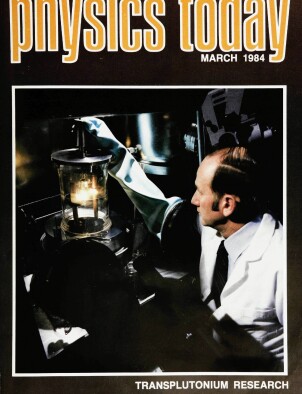New sources of high‐power coherent radiation
DOI: 10.1063/1.2916158
Recent progress in novel techniques for generating high‐power coherent radiation promises to make available sources with a variety of new and exciting applications. Interestingly, the new techniques have more in common with those used in the earliest sources of coherent radiation—the various microwave generators—than with those used in the more recent optical lasers. Development of new sources based on these techniques is proceeding rapidly at research centers around the world, because the new sources have a great potential for extending the currently available range of wavelengths and levels of power, while maintaining high operating efficiencies. The areas of application that stand to benefit include spectroscopy, advanced accelerators, short‐wavelength radar, and plasma heating in fusion reactors.
This article is only available in PDF format
References
1. N. M. Kroll, W. A. McMullin, Phys. Rev. A 17, 300 (1978).https://doi.org/PLRAAN
2. A. A. Kolomenskii, A. N. Lebedev, Sov. J. Quantum Electron. 8, 879 (1978).https://doi.org/SJQEAF
3. P. Sprangle, R. A. Smith, V. L. Granatstein in Infrared and Millimeter Waves, Vol. 1, K. J. Button, ed., Academic, New York (1979).
4. Free‐Electron Generators of Coherent Radiation, Physics of Quantum Electronics series, S. F. Jacobs, H. S. Pilloff, M. Sargent III, M. O. Scully, R. Spitzer, eds., Addison‐Wesley, Reading, Mass. (1980), volumes 7, 8 and 9.
5. R. Davidson, W. McMullin, Phys. Fluids 26, 840 (1983).https://doi.org/PFLDAS
6. H. Fleischmann, PHYSICS TODAY, May 1975, page 35.
7. V. L. Granatstein, M. E. Read, L. R. Barnett in Infrared and Millimeter Waves, vol. 5, K. J. Button, ed., Academic, New York (1982).
8. IEEE Trans. Microwave Theory Tech. (special issue) MTT‐25, No. 6 (1977).
9. The Free Electron Laser, the report of the free‐electron‐laser subcommittee of the Solid State Sciences Committee, National Academy of Sciences, National Academy Press, Washington, D.C. (1982).
10. P. J. Channell, ed., Laser Acceleration of Particles, AIP Conf. Proc. No. 91, Am. Inst. Phys., New York (1982).
11. L. R. Elias, W. M. Fairbanks, J. M. J. Madey, H. A. Schwettman, T. I. Smith, Phys. Rev. Lett. 36, 717 (1976).https://doi.org/PRLTAO
12. Bendor Free Electron Laser Conf., Journal de Physique 44, C1 (1983).
13. IEEE J. Quant. Electron. QE‐19, a special issue on free‐electron lasers (1983).https://doi.org/IEJQA7
14. A. A. Andronov, V. A. Flyagin, A. V. Gaponov, A. L. Goldenberg, M. I. Petelin, V. G. Usov, V. K. Yulpatov, Infrared Physics 18, 385 (December 1978).
15. V. A. Flyagin, A. G. Luchinin, G. S. Nusinovich, Int. J. Infrared and Millimeter Waves 3, 765 (1982).
16. Y. Carmel, K. R. Chu, M. Read, A. K. Ganguly, D. Dialetis, R. Seeley, J. S. Levine, V. L. Granatstein, Phys. Rev. Lett. 50, 112 (1983).https://doi.org/PRLTAO
17. L. R. Barnett, Y. Y. Lau, K. R. Chu, V. L. Granatstein, IEEE Trans. Electron Devices ED‐28, 872 (1981).https://doi.org/IETDAI
18. P. Sprangle, J. Vomvoridis, W. Manheimer, Phys. Rev. A23, 3127 (1981).https://doi.org/PLRAAN
19. N. A. Ebrahim, Z. Liang, J. L. Hirschfield, Phys. Rev. Lett. 49, 1556 (1982).https://doi.org/PRLTAO
20. R. A. Mahaffey, P. Sprangle, J. Golden, C. A. Kapetanakos, Phys. Rev. Lett. 39, 843 (1977).https://doi.org/PRLTAO
21. G. Bekefi, T. J. Orzechowski, Phys. Rev. Lett. 37, 379 (1976).https://doi.org/PRLTAO
More about the Authors
Phillip Sprangle. Naval Research Laboratory, Washington, DC.
Timothy Coffey. Naval Research Laboratory, Washington, DC.




